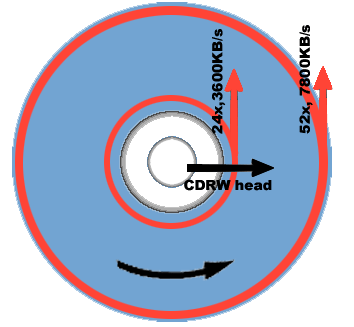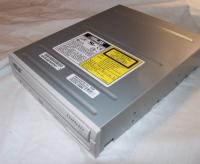ASUS CRW-5224A: CDR's Reach The End of the Line
by Kristopher Kubicki on January 13, 2003 7:26 PM EST- Posted in
- Storage
Features
Most of the features found on the CRW-5224A were similar to the features on the CRW-4012A-U we reviewed previously. The two more prominent features were FlextraLink and FlextraSpeed. For a full explanation of both of these technologies, please refer to the ASUS drive review we did last month.
The 5224A burns at 52x, a whopping 7800KB/s. Do not get too excited though, since the drive barely obtains speeds that high. Simply, the drive will obtain a speed of 52x when it reaches the most outreaches of the disk. The diagram below provides a visual explanation of constant angular velocity CD burning.
The CD rotates at a constant velocity while the CDRW head moves out from the center of the disk at a constant velocity as well. A little math shows that the circumference of a circular path is two times pi times the radius. In simplified terms, the innermost rings are shorter than the rings on the outside of the disk. Since the disk is spinning at a constant rate, at the beginning of the burn the CDRW head is exposed to less of the disk surface at the beginning of the burn than at the end. In order for the CD to burn at a constant 52x, the CD would have to start spinning at a very fast velocity and then gradually slow down as the CDRW head moves outward. Unfortunately, the CD would melt if it were to spin that fast.
One solution to this problem is instead of a CAV (constant angular velocity), the writer burns at Z-CLV, or zone-constant linear velocity. Basically, the CD slows down while the CD head moves out, but only for short periods of time. Once the head gets to a certain point in the CD, the drive spins up again and the process repeats. The last ASUS drive we reviewed, the CRW-4012A-U used this method of burning instead of CAV.
We were a little critical
about the CRW-4012A-U not supporting












4 Comments
View All Comments
Anonymous User - Tuesday, July 29, 2003 - link
Why didn't they make the CD-RW and DVD-RW writting standard like a hardrive? Why couldn't they have used HPFS, or even FAT32 instead of the sequential writting style? It probably would of been a lot quicker to read an write, and you wouldn't need some silly floppy image at the beginning of your CD to make it bootable.rayahari - Friday, August 6, 2010 - link
Hey guys its a nice and fast drive.New one avaible on Ebay for lowwwest price - http://cgi.ebay.com/ws/eBayISAPI.dll?ViewItem&...
wisetech - Monday, October 14, 2019 - link
Inbox wisetechhacker at g mail dot com or text +1{917}5085328 for the services of a certified and ethical hacker to change college grades,clear criminal records etc...hit me up and it's doneAprilLee - Wednesday, March 18, 2020 - link
What was the need to introduce CRW-5224A when already the features were present in CRW-4012A-U.? I think instead of wasting time on describing the same thing one must focus on the flaws of this CD at https://assignmentjunkie.co.uk/homework-writing-se... and then introduce something better than the previous.